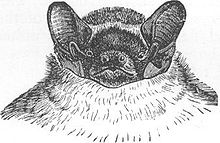- Lesser Noctule
-
Lesser Noctule/Leisler's Bat 
Conservation status Scientific classification Kingdom: Animalia Phylum: Chordata Class: Mammalia Order: Chiroptera Family: Vespertilionidae Genus: Nyctalus Species: N. leisleri Binomial name Nyctalus leisleri
(Kuhl, 1817)The Lesser Noctule or Leisler's Bat (Nyctalus leisleri) is a species of bat belonging to the vesper bat family, Vespertilionidae.
Contents
Description
It is a medium-sized bat, slightly smaller than the Common Noctule. It has a length of 48 to 68 mm (head and body) and a wingspan of 260 to 330 mm. The forearm measures 38 to 47 mm and the bat's weight is 11 to 20 grams. The face, ears and wings are dark. The fur is brown, darker at the base than the tip unlike that of the Common Noctule which is the same colour all along its length. The undersides of the arms are hairy giving it the alternative name "Hairy-armed Bat". The ears are short and rounded with a mushroom-shaped tragus. The wings are long and narrow.
Distribution
The Lesser Noctule is found locally across Europe and western Asia, eastwards as far as the Urals and Himalayas. It is also found in north-west Africa, the Canary Islands and Madeira. The form in the Azores is often considered to be a separate species - Azores Noctule (Nyctalus azoreum).
It is typically found in forests, both coniferous and deciduous, but has also adapted to parkland and urban areas and frequently roosts in buildings.
In most parts of its range, the Lesser Noctule is rare but in Ireland it is much commoner. In Britain it is known from a few colonies in England and Wales with occasional wanderers reaching Scotland. Threats to its survival include declines in large insects, loss of forest and hollow trees and toxic chemicals found in treated timber in buildings.
Feeding
The bats emerge soon after sunset to feed on flying insects such as moths and beetles. They fly straight and fast with shallow dives, often at treetop level. They sometimes feed around streetlights, catching the insects attracted to them. They are most active around dusk and dawn and will travel up to 10 km while foraging.
Reproduction
Lesser Noctules usually breed in small colonies of around 20 to 50 individuals but in Ireland they can be much larger. The colony is usually in a hollow tree or building; bat boxes may sometimes be used. The females give birth to one or two young with twins being more common in the eastern part of the range.
Echolocation
The frequencies used by this bat species for echolocation lie between 25-54 kHz, have most energy at 29 kHz and have an average duration of 8.5 ms. [1][2]
Other
The species was named to honour the naturalist Johann Philipp Achilles Leisler
References
- Chiroptera Specialist Group (1996). Nyctalus leisleri. 2006. IUCN Red List of Threatened Species. IUCN 2006. www.iucnredlist.org. Retrieved on 05 December 2006.
- Frank Greenaway & A. M. Hudson (1990) A Field Guide to British Bats, Bruce Coleman Books, Uxbridge
- Wilfried Schober & Eckard Grimmberger (1993) Hamlyn Guide: Bats of Britain and Europe, Hamlyn, London.
- R. E. Stebbings & Francesca Griffith (1986) Distribution and Status of Bats in Europe, Institute of Terrestrial Ecology, Huntingdon.
- S. Zera & P. Myers (2004) Nyctalus leisleri, Animal Diversity Web. Accessed December 05, 2006.
- ^ Parsons, S. and Jones, G. (2000) 'Acoustic identification of twelve species of echolocating bat by discriminant function analysis and artificial neural networks.' J Exp Biol., 203: 2641-2656.
- ^ Obrist, M.K., Boesch, R. and Flückiger, P.F. (2004) 'Variability in echolocation call design of 26 Swiss bat species: Consequences, limits and options for automated field identification with a synergic pattern recognition approach.' Mammalia., 68 (4): 307-32.
External links
- ARKive Photographs
- Woodland Management For Bats Guide
Categories:- IUCN Red List least concern species
- Vesper bats
- Mammals of Russia
- Mammals of Estonia
- Mammals of Lithuania
- Mammals of Sweden
- Mammals of the United Kingdom
- Mammals of Latvia
- Mammals of Belarus
- Mammals of Ukraine
- Mammals of Poland
- Mammals of Germany
- Mammals of the Netherlands
- Mammals of Belgium
- Fauna of the Isle of Man
- Mammals of the Republic of Ireland
- Mammals of France
- Mammals of Luxembourg
- Mammals of the Czech Republic
- Mammals of Slovakia
- Mammals of Kazakhstan
- Mammals of Switzerland
- Mammals of Liechtenstein
- Mammals of Austria
- Mammals of Italy
- Mammals of Hungary
- Mammals of Romania
- Mammals of Moldova
- Mammals of Slovenia
- Mammals of Croatia
- Mammals of Bosnia and Herzegovina
- Mammals of Serbia
- Mammals of Montenegro
- Mammals of Kosovo
- Mammals of Spain
- Mammals of Andorra
- Mammals of Monaco
- Mammals of San Marino
- Mammals of Bulgaria
- Mammals of Georgia (country)
- Mammals of Portugal
- Mammals of Albania
- Mammals of the Republic of Macedonia
- Mammals of Greece
- Mammals of Turkey
- Mammals of Armenia
- Mammals of Azerbaijan
- Mammals of Iran
- Mammals of Turkmenistan
- Mammals of Pakistan
- Mammals of Libya
- Mammals of Algeria
- Mammals of Morocco
- Fauna of Madeira
- Fauna of the Canary Islands
- Mammals of Great Britain
Wikimedia Foundation. 2010.


